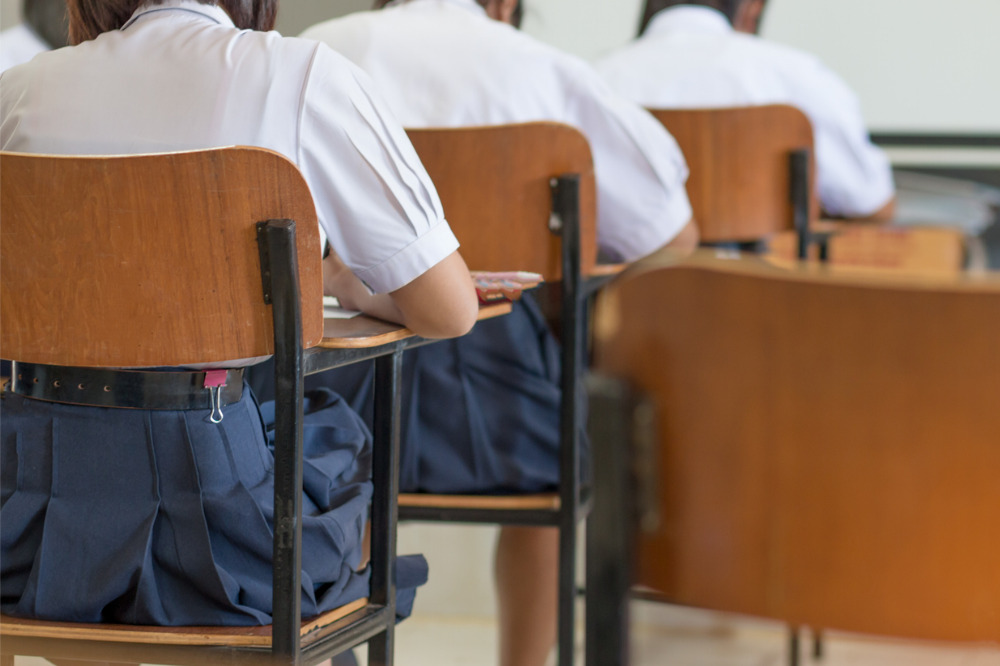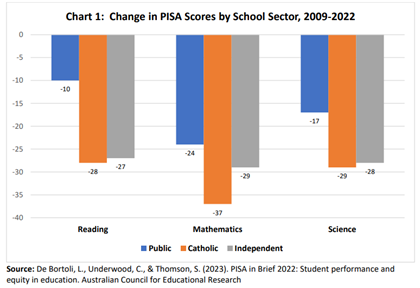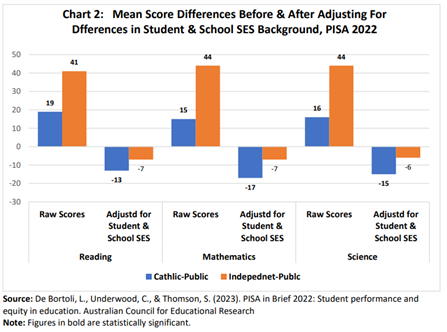
Catholic and Independent schools had the biggest declines in PISA test results since 2009, with their students losing 1½ to nearly two years of learning in reading, mathematics and science – far greater than the losses for public school students.
This is according to an education policy comment by Save Our Schools’ national convenor, Trevor Cobbold, who analysed the latest PISA data relative to how the three main school sectors in Australia performed.
“The learning loss in Catholic and Independent schools occurred even though they were heavily favoured by government funding increases since 2009,” Cobbold said.
Cobbold pointed out that while Commonwealth and state/territory funding for Catholic and Independent schools increased (adjusted for inflation) compared to that of public schools, the reading learning loss in Catholic and Independent schools was nearly three times that in public schools.

According to Cobbold’s analysis, Catholic reading results fell by 26 points, and by 27 points in Independent schools compared to 10 points in public schools, while the learning loss in private schools was almost equivalent to 18 months of school compared to six months in public schools.
Mathematics results fell by 37 points in Independent schools, which is equivalent to nearly two years of learning, and by 29 points in Catholic schools compared to 24 points in public schools. The learning loss in science in Catholic and Independent schools was nearly 18 months. Science results fell by 28 points in Independent schools and by 29 points in Catholic schools compared to 17 points in public schools.
Public schools perform just as well, if not better, than private schools
Cobbold said the new PISA results refute claims that private schools have better results than public schools.
“The report on Australia's PISA results shows that higher raw scores for Catholic and Independent schools are solely due to their more advantaged student demographic profiles,” Cobbold said.
“The report shows that public schools have nearly double the proportion of students from low SES families as Catholic schools and nearly three times the proportion in Independent schools – the respective proportions are 33%, 18%, and 12%.”
At the same time, says Cobbold, public schools have a much smaller proportion of students from high SES families – 18% compared to 29% in Catholic schools and 40% in Independent schools.
“These differences in socio-economic composition impact on school results, and the impact is particularly large in Australia compared to many other countries,” he said.
“The socio-economic gradient in Australia in mathematics is 45, meaning a 45-point increase in mathematics results for every one unit increase in the PISA measure of SES. It is significantly higher than the average for the OECD of 39 while Singapore had the highest gradient of 51.”

The report also adjusted the raw PISA scores for differences in the SES composition of the school sectors, finding that public schools outperform Catholic schools after adjusting for differences in the socio-economic status (SES) of students and schools.
“The adjustment shows that public school results exceeded that of Catholic schools by 13 points in reading, 17 points in mathematics, and 15 points in science [Chart 2]. The differences amount to more than six months of learning,” Cobbold said.
“While the adjustment for SES student and school background shows that public schools outperformed Independent schools by 6-7 points in each subject, this is not statistically significant. Clearly, public schools are performing at least as well as, if not better than, independent schools.”
Cobbold said these are remarkable results given that Independent schools have a sizable resource advantage over public schools, partly due to their huge increases in government funding.
“In 2021 income per student in Independent schools was 46% higher than in public schools while it was 12% higher in Catholic schools,” Cobbold noted. “Even the right-wing Centre for Independent Studies acknowledged that public schools "really do punch above their weight.”
Data raises questions over private school funding
Cobbold said that in view of these results, the question governments and taxpayers should be asking of private schools is “what they have done with their highly privileged funding increase”.
“There appears to be much wasteful expenditure amongst Catholic and Independent schools,” he said.
“It is apparent that the large increases in government funding have allowed them to devote much of their fee income to the arms race in gold-plated facilities such as well-being centers, ornate libraries, extravagant music and drama theaters, more swimming pools and ovals, buying up properties, etc.”
Cobbold said many of these schools have “exorbitant” salary packages for principals of up to $1 million and have extensive marketing budgets.
“None of this appears to be better educating their students,” he said.
“It is a credit to public school teachers that they have achieved such success under the duress of massive under-funding and the resource advantage of private schools.”
However, Cobbold said the under-resourcing of public schools is having a “disastrous” impact on the education of low SES, Indigenous, and remote area students, over 80% of whom attend public schools.
“The new PISA results show large achievement gaps between rich and poor in reading, mathematics, and science of five or more years of learning at age 15, and the gaps have widened since 2006,” he said.
“The failure to fully fund public schools is a major factor contributing to inequity in education outcomes. The chronic severe under-funding of public schools must end if progress is to be made on closing the achievement gap between rich and poor.”
Referring to Federal Education Minister, Jason Clare comment to ABC RN Breakfast last week that he wants to “close the funding gap and close the education gap”, Cobbold said that while this is a strong commitment, the question is "when."
“To date, he and his state/territory counterparts remain silent on when public schools will be fully funded. Their rhetoric must be matched by action which is long overdue.”


